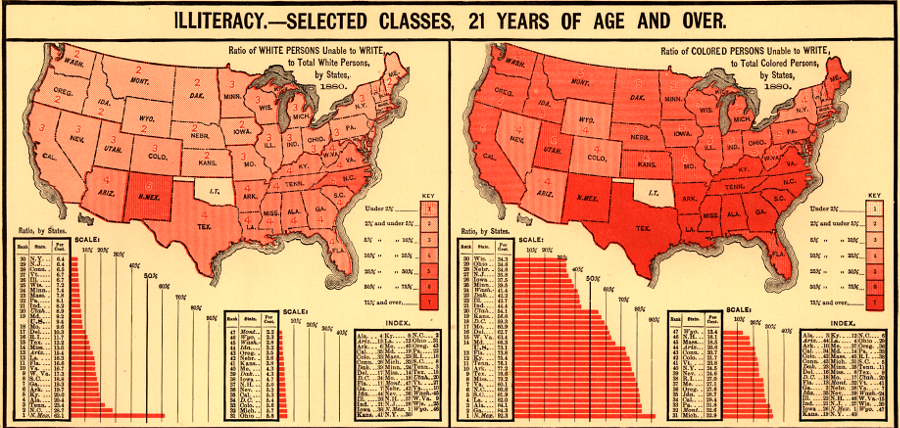
the literacy statistics in 1880 illustrate the effects of keeping slaves illiterate
Source: Library of Congress, "Scribner's Statistical Atlas of the United States," Plate 24: Population (Colored Population)

the literacy statistics in 1880 illustrate the effects of keeping slaves illiterate
Source: Library of Congress, "Scribner's Statistical Atlas of the United States," Plate 24: Population (Colored Population)
Education in Virginia focused initially on white males, and separate-but-equal education based on race or gender continued until 1997.
Only one public university in Virginia is named for a woman, the University of Mary Washington in Fredericksburg. It was formerly Fredericksburg State Teachers College, then converted in 1941 into "Mary Washington College." It served as the female co-ordinate liberal arts school of the University of Virginia, before going co-ed in 1970 and becoming an independent institution in 1972.1
The board considered changing the name of the school to Washington and Monroe University to attract more men, before a public uproar led to the final decision to choose the University of Mary Washington name in 2004.
Only after the civil rights movement, the failure of the Byrd Organization's massive resistance effort, passage of Title IX in the Education Amendments of 1972, and a 1996 Supreme Court decision would Virginia try to provide equal treatment in the public schools to all races and genders.
Virginia abandoned its last effort to maintain state-funded, separate-but-equal schools in 1997, when official gender discrimination ended at Virginia Military Institute (VMI). Excluding women from state-supported colleges, other than "normal schools" to train teachers, had been a long tradition in the state. Thomas Jefferson once wrote:2
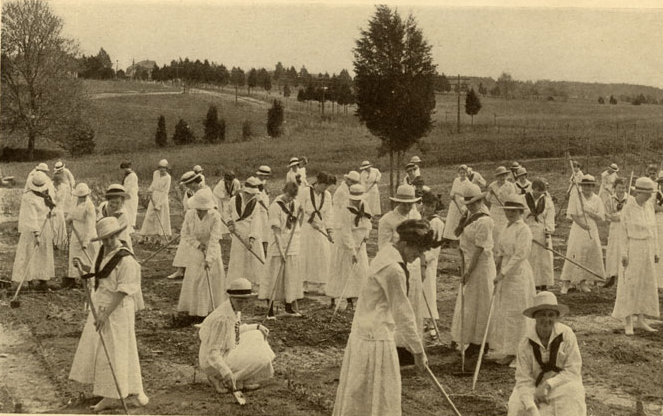
Mary Washington College in Fredericksburg was originally a "normal" school to train female teachers, before becoming the liberal arts co-ordinate college of the University of Virginia in Charlottesville and (since 2004) the University of Mary Washington
Source: Library of Virginia, At Work in the School Gardens View Book, State Normal School, Fredericksburg, Virginia (Date: c. 1919)
The University of Virginia in Charlottesville admitted women as first-year students in 1970, leading to the end of the formal arrangement since 1944 that women would attend Mary Washington College and men would attend UVA. In 1970, only one dormitory was co-ed. Men and women lived on different floors in that dorm (Watson), and mixing the genders was required because the Echols Scholar program was designed to be a residential learning community.
Virginia Military Institute in Lexington admitted women as "rats" in 1997.
Hampden-Sydney College in Farmville (a private school) is one of only a handful of accredited colleges in the United States that remain male-only. A traditional school saying that reflected the single-sex status is "Hampden-Sydney: Where men are men and women are guests." The school has trademarked the phrase and the college bookstore sells bumper stickers advertising it.3

In 2015, the female-only Sweet Briar College announced it would close. The decision was a surprise to students, faculty, local officials, and alumnae. One publication headlined the story "Sweet Briar College Commits Suicide."4
That school had offered a women-only liberal arts educational experience for 114 years and had a healthy endowment, but its leaders determined that it would not be possible to recruit enough students willing to pay nearly $50,000 annually for tuition and room-and-board. Sweet Briar offered most students a substantial discount and average costs were closer to $30,000 per year (reducing the $94 million endowment to $84 million in 2015), but the school officials decided to close down rather than offer greater discounts and eventually exhaust the financial resources.
The 3,250 acre campus in Amherst County was large enough to support an equestrian program with 18 miles of trails for riding horses. The downside of the rural location was that the college was 12 miles away from Lynchburg, over 50 miles from Charlottesville, and 70 miles from Roanoke. The campus was too isolated to offer a variety of night/weekend entertainment options or job-related internships at nearby companies.
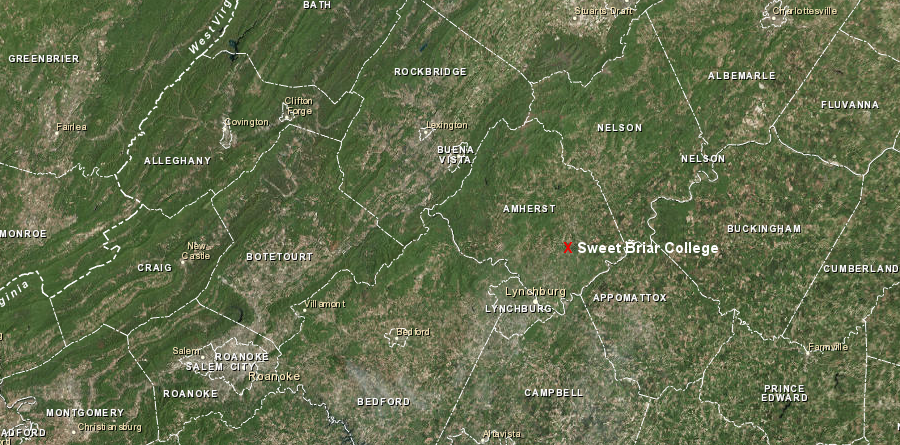
in addition to the difficulty of attracting students interested in a single-sex education, the isolation of Sweet Briar far from urban centers was a factor leading to the proposal to close the school in 2015
Source: ESRI, ArcGIS Online
The president noted "We are 30 minutes from a Starbucks," but equally-isolated Ferrum College and Hampden-Sydney are rural private schools that were still thriving. The critical factor in Sweet Briar's inability to attract enough students was the declining interest in a single-sex experience in a female college.
In the last 50 years, over 80% of the women's colleges in the United States and Canada had closed. There were 230 in 1960, but only 47 remained when Sweet Briar announced it would cease to operate as of August, 2015. Two female-only undergraduate colleges were left in Virginia, but Mary Baldwin College and Hollins College had already chosen to admit men to graduate school programs.5
Sweet Briar's board did considered going co-educational, the path chosen by Randolph-Macon Woman's College (now Randolph College) in 2007. Randolph-Macon Woman's College, located in Lynchburg, calculated that 95% of potential applicants would not be interested in attending a women-only school, and that the endowment would be exhausted in a dozen years. A portion of the Randolph-Macon Woman's College alumnae objected strongly to going co-educational after 115 years, but "Better Dead Than Co-Ed" protests and lawsuits failed to stop the change.
In 2015 Sweet Briar's leadership concluded that its base of contributors would not support admitting men; going co-educational would be too dramatic a change to the culture of the institution. As a private college, the school depended upon fund-raising and tuition to stay in business, rather than public funding appropriated by the General Assembly.
Alumnae from Sweet Briar College rebelled at the proposal to close the school, and local officials objected to the closure of the largest employer in Amherst County. The county attorney filed a lawsuit to force compliance with the terms of the original bequest from Indiana Williams that created the school on her Amherst County estate, once the home of 115 slaves prior to the Civil War. Her will created a charitable trust to support the school as a "perpetual memorial" to her deceased daughter Daisy.6
The lawsuit hinged on whether the college was a corporation where board decisions were not subject to review by the Virginia Attorney General, or if Sweet Briar was operating as a trust and public officials were entitled to engage to ensure compliance with the original terms. In the 1960's, the Virginia Attorney General had filed a lawsuit to enforce the original terms of Indiana Williams's will and block it from desegregating. The US Supreme Court removed the racial restriction, but the case set a precedent that public officials could intervene in the decisionmaking at Sweet Briar.7
In the end, the lawsuit was resolved through a negotiated agreement to keep Sweet Briar in operation in 2015-16, rather than close at the end of the 2014-15 school year. The president and nearly all board members who advocated for closing Sweet Briar College were replaced, and alumnae committed to raise $12 million in new donations.8
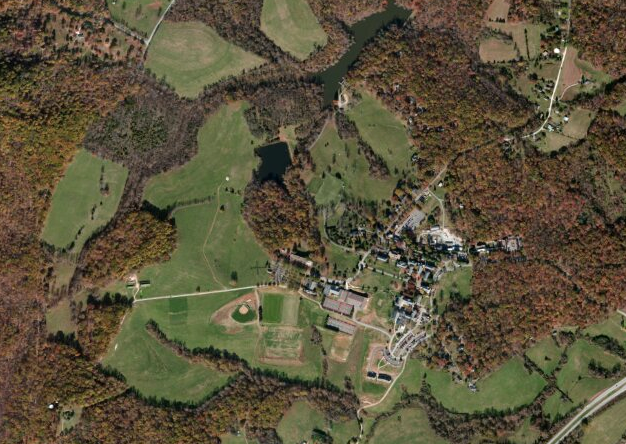
Sweet Briar's campus is in a pastoral setting, located in the rolling hills of the Virginia Piedmont
Source: ESRI, ArcGIS Online
The rebound of Sweet Briar continued after the COVID-19 pandemic. The 2021-22 class was expected to total 450 students, with 200 entering students replacing 100 who graduated. The school had about 600 students prior to the proposal for closure in 2015. With the announcement of the expansion of the student body for 2021-22, the college president commented:9
In 2021, the college had an entering class of 205 students. It was the largest number of new students since 2013, and as a result total enrollment climbed to 475 students.
In 2022, Sweet Briar reported gifts from the 14,000 alumnae exceeded $25 million. The schoool had received a total of $125 million in donations since closure was averted seven years earlier. The president of the college highlighted its unique status:10
>

teachers in Virginia's public schools were primarily female, and "normal schools" were established to train them
Source: Internet Archive, Harper's Weekly (November 9, 1867, p.1)
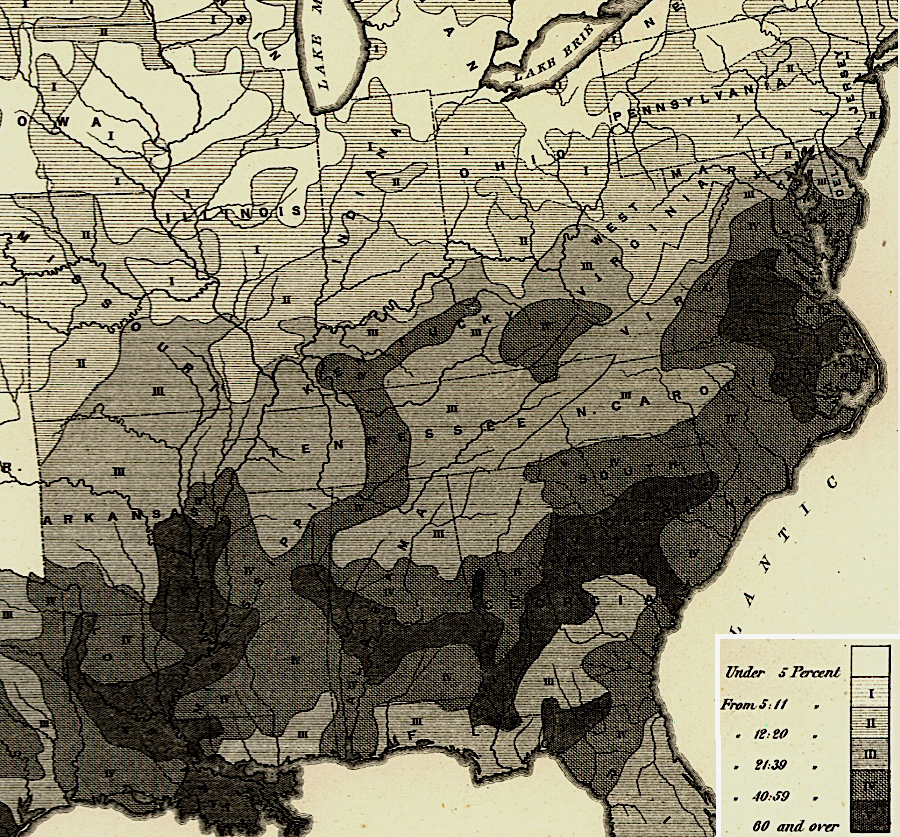
barriers to educating enslaved people prior to the Civil War were reflected in the illiteracy patterns of Southern states in the 1870 Census
Source: Mapping the Nation, Map of the Distribution of Illiteracy Compiled from the Ninth Census (by Arthur de Witzleben, 1872)